Books 27 May 2013 05:14 am
Tekenfilm
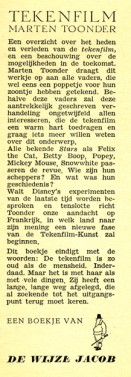 - Marten Toonder lived through much of the history of Dutch animation. (Like many other throughout Europe he gained the moniker of the “Walt Disney of Holland.”)
- Marten Toonder lived through much of the history of Dutch animation. (Like many other throughout Europe he gained the moniker of the “Walt Disney of Holland.”)
He was born in 1912 and died July, 2005. In 1940, with puppet animator, Joop Geesink, he formed the Geesink-Toonder Studio. The break-up of the two led to his forming the Toonder Studio in 1942.
He left this studio, as tituilar head, to get back to illustration in 1965, and ultimately retired in 1977.
Toonder is probably best remembered for his several successful comic strips. You can visit a sample of these here or here.
He made animated shorts of his comic strip, Tom Puss, which you can see on YouTube.
I make Toonder the subject of this post because I have an early book about animation which he wrote. Called Tekenfilm, it seems to have been written in 1946; at least that’s the only date I can find in the smallish publication.
It’s in Dutch, so I’m not able to read the book. However, I thought I’d post a couple of pages of the book . I haven’t been able to find any reference to the publication to date. ___________________The book’s flyleaf – in Dutch


The book’s Front cover & Back cover

Here the Fleischer studio gets credit for the Multiplane Camera.

I like the way Popeye is drawn. Koko looks more on model.
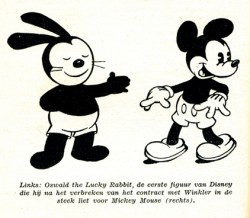
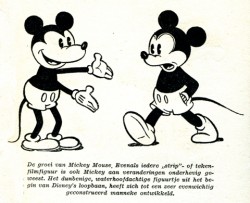
A wierd looking Oswald leads to Mickeys.

How to try to draw some characters.
Where’s Bugs?
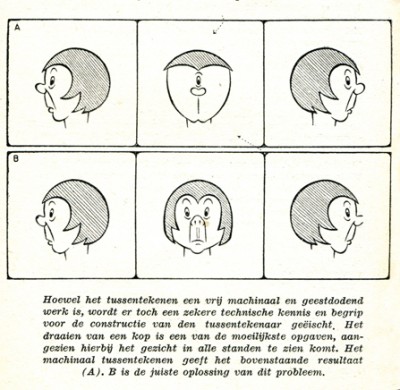
Here’s a lesson you still don’t see in many animation books.
How not to draw the mechanical inbetween.
His solution isn’t the best.

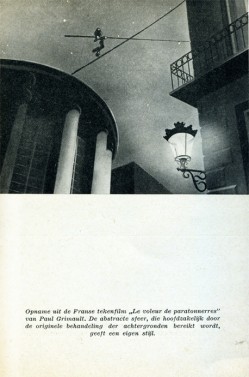
Ending with two European cartoons of merit from 1944:
The Snowman in July by Hans Fischer-Kösen
and Voleur de Paratonnerres by Paul Grimault

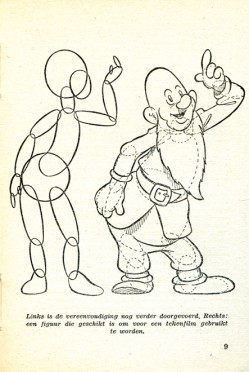






on 29 May 2013 at 2:17 am 1.Matt Jones said …
Good find Michael, I’ve been trying for years to track down a stop-mo ad Geesink did in Searle’s style for Lemon Hart Rum.
Which reminds me-I’m working on a book of Searle’s ‘American era’ work and hope to include a section on his animated work in the States. I’d love to include high res images of the ‘Energetically Yours’ frames you posted last year-any chance you could put me in touch with the owner?
on 29 May 2013 at 6:24 pm 2.Gijs Grob said …
Great to see an article on Marten Toonder, who’s indeed regarded as the Dutch Disney – not only because of his pioneering work in Dutch animation, but because of his enormous influence on the Dutch comic scene. Many classic Dutch comic artists learned their art at the Toonder studios, including Dick Matena, Fred Julsing, Piet Wijn, and Thé Tjong-Khing. Indeed Marten Toonder’s comics have always been much more succesful than his animation work. His very own comic, ‘Tom Puss’ is regarded not only a comic classic, but even a literary classic in The Netherlands.
Toonder’s book ‘tekenfilm’ was indeed published in 1946. By then Toonder had five years of experience in the animation industry. Although during those war years he had to discover the laws of animation all by himself, he had had learned some of its principles from Jim Davis, an animator who had worked on Otto Messmer’s Felix the Cat, and whom he had met in Argentine in the 1930′s.
Toonder’s war years films are pretty primitive, even so, the quality improved a lot over the years. Remember that American films were no longer available in occupied Europe as soon as the war started, so Toonder’s only references were from the 1930′s (that’s why Bugs Bunny is absent – he probably was still totally unknown in The Netherlands at 1946).
However, by the early 1950′s the Toonder studios were capable of elaborate and beautiful films like ‘De gouden vis’ (the golden fish) and ‘Moonglow’. Unfortunately, Toonder’s artistic films never made him any money, and although the studios existed until the 1990′s, the last decades they made only commissioned films.
Toonder’s dream of a Dutch animation industry were never fulfilled. His dream of an animated feature length film came true in 1983, but it was a deception. It remains the only animated feature made in The Netherlands up to this present day.
on 29 May 2013 at 6:34 pm 3.Gijs Grob said …
B.T.W. in the description of the multiplane camera, Toonder really gives credit to Fleischer ánd Disney. He writes:
“Fleicher abandoned the principle of hanging cameras in animation. He used a mixture of normal, photographic film with backgrounds and drawings which were placed on a screen before the camera. Disney was more consistent. He built as so-called Multiplane camera, which was hung above his shooting table, and which could move up and down. Fleischer’s backgrounds were replaced by drawn backgrounds which were placed on different “planes” to get more depth, and where the camera could sink into. The French disapprove of this system, they think it violates the classic laws of drawn animation.”
on 29 May 2013 at 8:14 pm 4.Michael said …
Thank you, Gris, for such an excellent summary of Toonder’s career and influence on the animation industry. I’m afraid he’s too little known in the U.S. His films are worth looking for.
on 31 May 2013 at 4:18 am 5.Gijs Grob said …
One year ago the following book was published ‘De Toonder Animatiefilms’ [The Toonder animation films]: a gorgeous book with lots of illustrations documenting the history of the Toonder studios. The book is unfortunately in Dutch only, but it does contain a DVD with a sample of films by the Toonder Studios, including early Tom Puss films, the first stop motion films by Joop Geesink & Marten Toonder, and Toonder’s masterpieces ‘De gouden vis’ en ‘Moonglow’.
http://www.bol.com/nl/p/de-toonder-animatiefilms/9200000000907314/
***
And I forgot to mention this: the most famous animator who worked at the Toonder studios should be Borge Ring, a Danish-Dutch animator, who won an Academy Award for his own film ‘Anna and Bella’ in 1985. Ring worked for Toonder from 1952 till 1973.